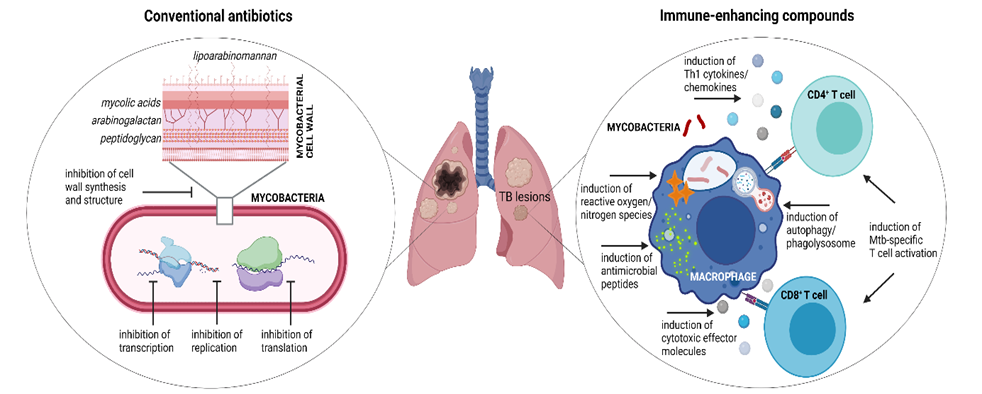“The immune system is critical in fighting tuberculosis but sometimes needs help. Immune-enhancing therapies offer new hope by strengthening the body’s defences against the infection.” – Susanna Brighenti
Tuberculosis (TB) remains one of the most fatal infectious diseases globally, causing approximately one death every 20 seconds. The persistence over time of Mycobacterium tuberculosis (Mtb) in human hosts is a result of its ability to infect and manipulate immune cells. This unique feature of Mtb poses significant challenges in treatment procedures, leading to complications in disease management.
The complex interplay between the host immune system and the infective agent has long been an area of active research, with the aim of developing effective therapeutic strategies against TB. The emergence of multidrug-resistant TB (MDR-TB) has further complicated the scenario, highlighting the urgent need for alternative treatment options. Despite advances in TB research and management, the global burden of TB remains high, and efforts to combat this disease continue to be a significant public health priority.
Susanna Brighenti, a distinguished group leader at the Karolinska Institutet and an accomplished associate professor of immunology at ANA Futura in Flemingsberg, was awarded funding in 2019 from the PAR Foundation for her innovative research project exploring the use of nutritional compounds to restore protective immune responses in tuberculosis (TB) infection. This exciting initiative aims to advance the understanding of the immune system’s response to TB infection and identify new strategies to combat this global threat. The funding from the PAR Foundation represents a significant milestone in the development of this vital research and underscores the importance of innovative research in advancing our knowledge of infectious diseases.
Immune-stimulating agents improve immune cell function to boost the body’s ability to combat pathogens, in contrast to antibiotics and other drugs that are aimed at eliminating microorganisms. The major objective is to adopt such immune-enhancing therapy as an additional treatment option that could increase the effectiveness of conventional antibiotics and lessen the emergence of antimicrobial resistance (AMR) in TB. In other words, it’s like giving your immune system an energy drink so it can fight off infections like a champ.
When someone has TB, antibiotics can be used to stop the bacteria from growing and spreading in their body. However, some TB bacteria can become resistant to antibiotics, making it harder to treat the infection. In addition to antibiotics, researchers are exploring the use of immune-enhancing compounds to help the body fight the infection. These compounds work by activating immune cells, such as macrophages and T cells, which can assist in killing of the bacteria. It’s like giving the body an extra boost to fight the infection. The picture below shows how these immune-enhancing compounds can help the body fight TB.
As a result of the PAR-funded project, Susanna’s research team has increased the number of HDAC inhibitors in their arsenal and discovered a particular class of drugs that successfully control particular host immune cell pathways to promote bacterial death. This work was completed at SciLife Lab in Solna in collaboration with colleagues from Linköping University and the Chemical Biology Consortium Sweden (CBCS). The study received extra financing from the Swedish Heart-Lung Foundation (HLF) and the Scientific Research Council (VR), both of which have made a contribution.
In summary, this finding has the potential to impact the therapeutic management of TB and, in particular, MDR-TB disease at a time when antibiotic resistance poses a serious threat to human health. It could additionally influence fresh ideas for immunotherapy against different bacterial illnesses.
Articles related to the funded project in which PAR has been acknowledged are listed below:
- Reinventing the human tuberculosis granuloma: Learning from the cancer field here
- Anemia is a strong predictor of wasting, disease severity, and progression, in clinical tuberculosis (TB) here
- Immunosuppressive features of the microenvironment in lymph nodes granulomas from tuberculosis and HIV co-infected patients here
- Immunomodulatory agents combat multidrug-resistant tuberculosis by improving antimicrobial immunity here
- Polarization of M1 and M2 human monocyte-derived cells and analysis with flow cytometry upon Mycobacterium tuberculosis infection here
- Polarization of human monocyte-derived cells with vitamin D promotes control of M. tuberculosis infection here
Tuberculosis (TB) remains one of the most fatal infectious diseases globally, causing approximately one death every 20 seconds. The persistence over time of Mycobacterium tuberculosis (Mtb) in human hosts is a result of its ability to infect and manipulate immune cells. This unique feature of Mtb poses significant challenges in treatment procedures, leading to complications in disease management.
The complex interplay between the host immune system and the infective agent has long been an area of active research, with the aim of developing effective therapeutic strategies against TB. The emergence of multidrug-resistant TB (MDR-TB) has further complicated the scenario, highlighting the urgent need for alternative treatment options. Despite advances in TB research and management, the global burden of TB remains high, and efforts to combat this disease continue to be a significant public health priority.
Susanna Brighenti, a distinguished group leader at the Karolinska Institutet and an accomplished associate professor of immunology at ANA Futura in Flemingsberg, was awarded funding in 2019 from the PAR Foundation for her innovative research project exploring the use of nutritional compounds to restore protective immune responses in tuberculosis (TB) infection. This exciting initiative aims to advance the understanding of the immune system’s response to TB infection and identify new strategies to combat this global threat. The funding from the PAR Foundation represents a significant milestone in the development of this vital research and underscores the importance of innovative research in advancing our knowledge of infectious diseases.
Immune-stimulating agents improve immune cell function to boost the body’s ability to combat pathogens, in contrast to antibiotics and other drugs that are aimed at eliminating microorganisms. The major objective is to adopt such immune-enhancing therapy as an additional treatment option that could increase the effectiveness of conventional antibiotics and lessen the emergence of antimicrobial resistance (AMR) in TB. In other words, it’s like giving your immune system an energy drink so it can fight off infections like a champ.
When someone has TB, antibiotics can be used to stop the bacteria from growing and spreading in their body. However, some TB bacteria can become resistant to antibiotics, making it harder to treat the infection. In addition to antibiotics, researchers are exploring the use of immune-enhancing compounds to help the body fight the infection. These compounds work by activating immune cells, such as macrophages and T cells, which can assist in killing of the bacteria. It’s like giving the body an extra boost to fight the infection. The picture below shows how these immune-enhancing compounds can help the body fight TB

